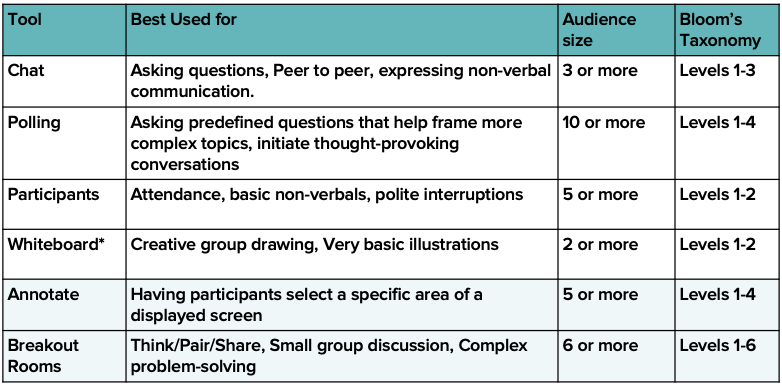CHECK FOR UPDATES: This is an evolving document and will be updated as product updates are made and new lessons are learned. Always check percipiocompany.com for the latest version. The first five sections are platform agnostic and can be applied in most virtual rooms.
Adopt a Virtual Mindset
Whether you are a participant or a facilitator in a virtual meeting, it is imperative to adopt what we refer to as a “virtual mindset”. This is a willingness to explore how to best communicate ideas during a virtual meeting. The most common mistake organizers make when preparing for a virtual meeting is that they structure it the same as an in-person meeting. They forget about the lack of non-verbal communication, executive presence, and structure needed to foster inclusion, collaboration and innovation.
Virtual meetings CAN be even more effective than in-person IF you change your mindset and the way you design them. Inclusive Leaders know this and have already begun implementing key leadership traits into our new normal, virtual workplace. This guide is designed to help you thrive in a virtual world.
Before the Meeting: Send a Prep Email to Participants
An email to set expectations, meeting guidelines and help attendees get ready will keep your meetings running smoothly. The following is a sample. Use as much or as little as you see fit. It was written platform-agnostic so fill-in the space between the [brackets].
**********************
We look forward to hosting you in our virtual meeting room! In preparation, please complete the following prior to our meeting.
- Download [the virtual meeting software] on the device you will use for the meeting.
- Login and test your audio. This is mandatory as it is one of the most common problems. Become familiar with the user interface controls.
- BE SURE to locate the Mute/Unmute button. Please keep yourself on Mute until you are invited to speak.
- When you join, use only ONE audio channel; if you join using your computer audio, do NOT dial-in as well – you will create and hear an echo. If you do dial-in, know how to mute. For example, *6 allows you to switch between mute and unmute on some conference call systems.
- Video is optional but strongly encouraged. If you are at home, make sure you are prepared to be seen.
- Check the position of your camera. Make sure your camera is eye-level (or above) and 2-3 feet or more from your face. You don’t want to “look down” on people and people don’t want to look up at your nose hairs!
- Check the lighting. Natural light is best but make sure your facial expressions can be seen and you are not a silhouette.
- Check your surroundings. What can be seen by the camera? What do you want to be seen by the camera?
- Take this opportunity to share something unique about yourself with the other participants. For example, a lapel pin, hat, book in front of you or picture behind you? Be creative.
- There will likely be opportunities for each person to contribute during the meeting in meaningful ways.
- The Chat feature will be available to type individual responses/questions/comments.
Relax, have fun and take comfort in that we are all being as safe as possible during these uncertain times.
**********************
Participant Best Practices
The best practices listed below are based on being invited to a virtual meeting (many-to-many) NOT a webinar (one-to-many). Some of the items apply to webinars but the real trick to a listen-only (one-to-many) webinar is to pay attention and not let your mind wander off to check email or play on your phone. The best practices defined below are based on you having an active voice and being a meaningful contributor to the virtual meeting. If you are not expected to contribute, it’s safe to question why you were invited to the meeting in the first place!
Plan to join using your camera.
- If you are at home, make sure you are prepared to be seen.
- Check the position of your camera. Make sure your camera is eye-level and 2-3 feet or more from your face.
- Check the lighting. Natural light is best but make sure your facial expressions can be seen and you are not a silhouette.
- Check your surroundings. What can be seen by the camera? What do you want to be seen by the camera?
- Take this opportunity to share something unique about yourself with the other participants. For example, a lapel pin, hat, book in front of you or picture behind you? Be creative. If your platform allows for virtual backgrounds, be sure you match your meeting. For example, a professional background for virtual business meetings. Use your best judgement as sometimes the virtual backgrounds distract from, rather than contribute to, the purpose/goals of the meeting.
- Ask people sharing your space to avoid walking behind you while you’re on camera so they don’t distract from the meeting.
- Look professional – dress as if you were attending a live event. At least from the waist up!
- When someone is talking, focus on what they are saying. Visual communication and body language convey so much. Active listening is essential during in-person meetings and even more so in virtual.
- When it is your turn to speak, unmute yourself and look at the camera! Your presence and communication will be stronger.
- If you do need to step away, mute your mic and turn your camera off. If appropriate, send a text to the host to let them know when you will return.
Reduce/eliminate background noise.
- Join audio via your laptop and wear headphones when possible.
- Try to remove yourself from family/pets when joining a call.
- Mute yourself whenever you are not speaking. For example, *6 allows you to switch between mute and unmute on some conference call systems.
Test your technology.
- Download the virtual meeting software on the device you will use for the meeting.
- Login and test your audio. This is mandatory as it is one of the most common problems. Become familiar with the user interface controls.
- Login, launch/start a meeting and test your audio. This is mandatory as it is one of the most common problems. In the Zoom app window, the “Mute/Unmute” button in the lower left corner also serves as a volume meter when you’re speaking. If the meter doesn’t flash green when you speak, others in the meeting might not hear you.
- If you have issues connecting, try some basic troubleshooting:
- Confirm you’re using the right meeting link.
- Switch to Chrome as your browser and retry.
- Restart your computer and try again.
- If NONE of the above work, just dial-in using your phone.
Be present.
- Close other applications on your computer. Don’t surf or check email.
- Etiquette – every meeting will be different, please practice good common sense and err on the side of graciousness.
- Norms for a meeting – if meeting organizers have requested certain ground rules, please familiarize yourself with them and comply.
- Participate! Most meetings are intended to be interactive, but be sensitive to the “feel” of the meeting. Engage in chat, participate in polls and other activities.
- If you would like to speak, be aware of ground rules and best practices – for example some meetings will ask you to “Raise Hand” before you speak, it won’t be necessary for other meetings.
- Be concise if you speak, and stay on topic, especially if you are one of many invited attendees. The facilitator is running the meeting and should be granted the respect to best accomplish meeting goals.
- Use “Mute / Unmute.” Please mute if someone is delivering a presentation. Remember to UNMUTE if you need to say something.
- “Stop Video” and “Mute” for personal breaks, e.g. eating as others speak. A sip of coffee on camera is fine, food on camera is best avoided.
- Consider placing your phone out of arm’s reach. If the meeting is no longer than 90 minutes, the call/text or whatever can likely wait.
- Remember – if the meeting is worth your time, it’s worth your focus!
- Use chat to share questions or feedback with the Host or Group Monitor during the call to make sure you’re getting what you need from the experience.
Facilitator Best Practices
- First decision is what type of virtual meeting: one-to-many or many-to-many. If one-to-many, use a webinar and focus on visuals, messaging, flow, etc. Similar thinking applies to panel presentations or if a small number of people are presenting to a larger audience. However, if many-to-many communication is desired, voices need to be heard, input is necessary from participants, you really need to consider a different approach.
- Review the Privacy and Security Practices for your virtual meeting platform. Have participants register with name and email if offering this outside of your company firewall or network.
- Consider the number of participants. Who are they? What roles/departments? Levels in organization (Power dynamics)? Do they even know each other?
- How can you best use the time together? What information can be gathered before?
- What information can be sent ahead of time? How will it be used during the meeting?
- Start by writing out your agenda.
- Think through each agenda item in terms of the best way to communicate it. Don’t assume one-to-many. There are tools that can be used to maximize impact. Be intentional to have the greatest impact!
- Use some type of interactive ice breaker activity to set the tone for your meeting. Email mcahill@percipiocompany.com for ideas.
- Consider your audience. Who needs to be in this meeting? Whose voice must be heard? How can you invite them to share? Structuring the conversation is essential as there is only one audio channel. There is an implicit bottleneck.
- When it is your turn to speak, unmute yourself and look at the camera! Your presence and communication will be stronger.
- Set ground rules – depending on the size and nature of the meeting, these can be useful and important. See below.
- Be comfortable and confident with all controls/tools/features in the virtual meeting room. At a minimum, you need to have all your content ready and seamlessly transition between content and conversation.
- For any virtual gathering of more than 4 people, it is best to have a “Virtual Admin” to assist “behind the scenes.” This allows the facilitator to focus on presenting information, managing the “flow” of the meeting and keeping the energy up while the admin handles chat questions and other details. See Virtual Admin section below.
Ground Rules
If you do use ground rules, communicate them via email in advance – and go over them at the beginning of the meeting as well. Sharing a presentation Slide with ground rules listed – as the facilitator goes through them – works well. Here are a few things to consider:
- Mutual respect – if it’s a large or public audience, or dealing with contentious or sensitive material, it can be beneficial to request a respectful meeting from the outset.
- Etiquette such as “Mute / Unmute” and “Stop / Start Video” – consider how you’d like attendees to be seen and heard.
- Attendees “Raise Hand” to speak?
- Time limits on attendees speaking up? Do you need a timekeeper?
- Confidentiality? What personal or business information should – or should not – be shared? How shall the meeting deal with proprietary information, especially if the meeting reaches a wide audience with varying levels of need-to-know?
- Feedback policies – for example if you want a “no crosstalk” model, i.e. attendees should not criticize each other’s ideas or comments, declare that before the meeting.
Virtual Admin, Co-host or Co-facilitator
It is imperative to have someone to work with the meeting host or facilitator “behind the scenes” to assist with fielding questions, keeping you on time/agenda, and handling minor technical difficulties (mute/unmute). Here is a short-list that may serve well as a checklist for your next meeting!
- Welcome people as they enter using the Chat feature.
- Mute microphones that are causing extraneous noise. To mute all mics:
- Alt+M = Windows
- Command+Control + M = Mac
- Take attendance.
- During presentation and/or group discussion, serve as notetaker and write key points/insights/ideas into the chat window for Everyone to read. This often encourages others to contribute ideas and creates a record for the meeting.
- Remember to click the Record button (if applicable).
- Serve as a default Gatekeeper and ensure all voices are being heard.
- Handle minor technical issues that may occur during the meeting.
- Monitor the chat window and participant window for during the meeting. Notify the host/facilitator or provide Immediate reply when possible.
If all of this still feels overwhelming, email mcahill@percipiocompany.com and one of our trusted advisors will assist!
Zoom-specific Notes & Tools
The following section details some features and interactive elements that are all included with Zoom. Chat, Polling, Participants Pane and Whiteboard are widely accessible and configurable in most virtual meeting platforms.
Bloom’s Taxonomy of learning objectives has six levels:
- knowledge – what you know (facts)
- comprehension – what you understand (do you get it?)
- application – how you might put it to use
- analysis – how you drill down and organize the material
- synthesis – how you integrate various ideas into a unified whole
- evaluation – reaching conclusions and discovering solutions
*Do NOT try to use the whiteboard feature the same way you would in a physical conference room! Keyboards and mice are not markers. DO use it for a creative drawing exercise.
Breakout Rooms
Breakout Rooms (BRs) are unique and are the closest that humans have come to being transported like in Star Trek. The Zoom host can initiate BRs for larger groups to have smaller group discussions. Depending on the nature of the virtual meeting, the discussion topic will likely lend itself towards sharing what was discovered in the BR with the larger group when everyone returns to the main virtual meeting room.
Like most things, they can be incredibly powerful, spaces for more intimate, deeper conversations or they can be awkward and messy. They’re usually somewhere in-between. One of the common mistakes is trying to rush through them. Be sure to consider:
- Who is in the larger group? Do they know each other? Have they used Breakout Rooms before?
- Allow time for each small group to get comfortable with one another (assuming they don’t know each other & you are randomly assigning people).
- If the BR has 4 or more participants, establish roles. Some examples are:
- Notetaker – take notes during the breakout session.
- Presenter – Concise summary of breakout room discussion.
- Gatekeeper – a person that ensures all ideas are being heard. Invites people to participate.
- Reporting back to the larger group in some meaningful way (ideally w/o being redundant).
- Capture the BR notes in the main virtual meeting room chat. This can be a simple copy/paste if the BR notetaker was using notepad or Word to take notes.
- The Host can also “float” in to and out of the various BRs. This is nice when you just want to check-in with folks to see how the conversations are going.
- You may want to pause the Zoom recording as it will continue in the empty main virtual meeting room. If enabled, each BR can be recorded individually.
Zoom Virtual Admin and/or Co-host
There are also some best practices that are unique to Zoom and will help improve the meeting experience for everyone.
- If you had participants register, resend the registration confirmation email 1-hour prior to the meeting. It contains their unique url and makes it easier for them to access the meeting.
- Admit people from the waiting room (if enabled).
- Merge audio and video feeds to preserved screen real estate for Gallery View conversations.
- Setup and initiate Polls (if enabled).
- Schedule and manage breakout rooms (if enabled).
- Monitor the participant pane for questions and assist anyone unable to mute so the group is not distracted by extraneous background noise.
If you’re new to this role, check out the Zoom tutorials here:
Prep Email for Zoom Participants
**********************
We look forward to hosting you in our virtual meeting room! In preparation, please complete the following prior to our meeting.
- Download Zoom and/or create a Zoom Account. It’s free and takes 3-5 minutes. Zoom is VERY user-friendly and relatively goof-proof. Do this on the device you will use for our meeting.
- Login and test your audio. This is mandatory as it is one of the most common problems.
- If you have issues connecting, try some basic troubleshooting:
- Confirm you’re using the right meeting link.
- Switch to Chrome as your browser and retry.
- Use this link to test your internet connection, video and audio in a generic Zoom meeting.
- Restart your computer and try again.
- If NONE of the above work, just dial-in using your phone and skip steps 4-5 below..
- Become familiar with the Zoom controls.
- BE SURE to locate the Mute/Unmute button. Please keep yourself on Mute until you are invited to speak.
- When you join, use only ONE audio channel; if you join using your computer audio, do NOT dial-in as well – you will create and hear an echo. If you do dial-in, know how to mute. For example, *6 allows you to switch between mute and unmute on some conference call systems.
- Video is optional but strongly encouraged. If you are at home, make sure you are prepared to be seen.
- Check the position of your camera. Make sure your camera is eye-level (or above) and 2-3 feet or more from your face. You don’t want to “look down” on people and people don’t want to look up at your nose hairs!
- Check the lighting. Natural light is best but make sure your facial expressions can be seen and you are not a silhouette.
- Check your surroundings. What can be seen by the camera? What do you want to be seen by the camera?
- Take this opportunity to share something unique about yourself with the other participants. For example, a lapel pin, hat, book in front of you or picture behind you? Be creative.
- Explore using virtual backgrounds! On Zoom, look for the small arrow next to the Video button on the toolbar. Be sure you match your meeting. For example, a professional background for virtual business meetings. Test how your image is displayed. Sometimes the virtual background creates a blurred definition around the person using it. Test your system capabilities as it is novel but can be distracting.
- The Chat feature will be available to type individual comments/questions.
- There will likely be opportunities for each person to contribute during the meeting in meaningful ways.
MS Teams-specific Notes & Tools*
MS Teams is best used for internal communications and workflows within organizations that are what I refer to as “Microsoft” shops. MS Teams works really well when integrated with other Microsoft applications. It allows for distinct channels and chats for individual projects, departments, and groups.
One unique aspect of MS Teams are Channels and subchannels. These allow a Team Organizer to provide dedicated space for specific users, topics and content. The intent is to avoid clutter and confusion.
Much of the functionality is similar to other platforms but there are some distinct features outlined below.
- Persistent one-on-one or group chatting.
- Ability to search , filter and resume old chats.
- Hide/unhide, pin/unpin channels and messages for focus
- Chat with co-worker(s) easily even outside of meetings.
- Send messages to colleagues worldwide even when they are offline.
- Allows convenient sharing of documents, images, and files.
- Sync with Office 365 products such as Outlook and Sharepoint.
- Collaborate on documents.
- Access your favorite apps within Teams to enhance your workflow.
- Easy and efficient, one stop shop for conversation, file sharing, calls, and meetings.
- Customizable for organizational branding and security.
- Start meetings at a click wherever you are – from a Team/Channel/Chat.
- Align working groups and manage projects in one place.
- Real time collaboration allows for more effective workstreams.
- Share individual applications, documents or dashboard in meetings with colleagues.
- Whiteboard functionality for interactive activities.
- Polling capability for quick surveying.
These are some of the functionality that MS Teams brings to assist organizations in streamlining their workflow and communications.
*Yvonne Burton contributed to this section
Relax, have fun and take comfort in that we are all being as safe as possible during these uncertain times. If all of this still feels overwhelming, email mcahill@percipiocompany.com and one of our trusted advisors will assist!
**********************

Percipio Company is led by Matthew Cahill. His deep expertise in cognitive, social, and workplace biases is rooted in the belief that if you have a brain, you have bias®. He works with executives to reduce mental mistakes, strengthen workplace relationships & disrupt existing bias within current HR processes, meeting protocols and corporate policies. Matthew has demonstrated success with large clients like LinkedIn, Salesforce and dozens of small to mid-size companies looking to create more inclusive workplaces, work smarter, generate more revenue and move from bias to belonging®.







